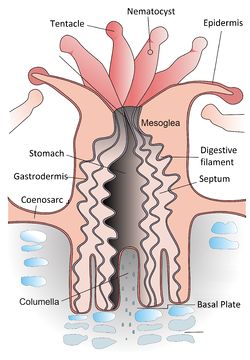CoralPolyps: Difference between revisions
From coraldigest
No edit summary |
No edit summary |
||
| Line 1: | Line 1: | ||
= Coral Polyps = | = Coral Polyps = | ||
Corals belong to the Ppylum Cnidaria and class Anthozoa. Corals exist as individual polyps or in colonies.<ref>NOAA, NOAA Coral Reef Conservation Program Coral 101. NOAA. Web. 5 Mar 2014. <http://coralreef.noaa.gov/aboutcorals/coral101/>. </ref>. | |||
*talk about what a Polyp is and where they are found <ref>Gray, Susan Heinrichs. Coral Reefs. Minneapolis, Minn: Compass Point Books, 2000. eBook Collection (EBSCOhost). Web. 22 Feb. 2014.</ref> | *talk about what a Polyp is and where they are found <ref>Gray, Susan Heinrichs. Coral Reefs. Minneapolis, Minn: Compass Point Books, 2000. eBook Collection (EBSCOhost). Web. 22 Feb. 2014.</ref> | ||
==Anatomy== | |||
[[File:Coral polyp anatomy.jpg|right|250px| | |||
[[File:Coral polyp anatomy.jpg|right|250px|diagram of the polyp of a stony coral]] | |||
Revision as of 16:27, 5 March 2014
Coral Polyps
Corals belong to the Ppylum Cnidaria and class Anthozoa. Corals exist as individual polyps or in colonies.[1].
- talk about what a Polyp is and where they are found [2]
Anatomy

- Describe the different parts that make up the Polyp and what they do. (Tentacle, mouth, basal plate, etc.)[3]
- Explain how nerve cells loosely connect Polyps to one another creating a nerve net between a colony of Polyps
Symbiotic relationship with zooxanthellae
- Define symbiosis.
- Explain how Polyps and Zooxzanthellae have a symbiotic relationship. (what each does for each other)[4]
- Explain how through this relationship both are mutually benefited.
- Explain how the relationship is also obligative. Meaning that, in most cases, neither can live without the other.
Stony Coral and Soft Coral Coral
- Stony corals make a calcium carbonate skeleton, soft corals do not do this
Feeding
- How Polyps are able to use their tentacles to pull in zooplankton and small fish to their mouths
Reproduction
- Explain the process of reproduction
References
- ↑ NOAA, NOAA Coral Reef Conservation Program Coral 101. NOAA. Web. 5 Mar 2014. <http://coralreef.noaa.gov/aboutcorals/coral101/>.
- ↑ Gray, Susan Heinrichs. Coral Reefs. Minneapolis, Minn: Compass Point Books, 2000. eBook Collection (EBSCOhost). Web. 22 Feb. 2014.
- ↑ Pechenik, J. A. . Biology of the invertebrates. sixth. McGraw-Hill, 2010. print.
- ↑ NOAA, NOAA Coral Reef Conservation Program Coral 101. NOAA. Web. 5 Mar 2014. <http://coralreef.noaa.gov/aboutcorals/coral101/>.